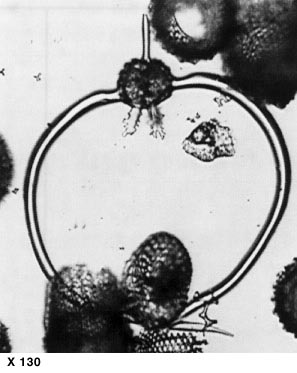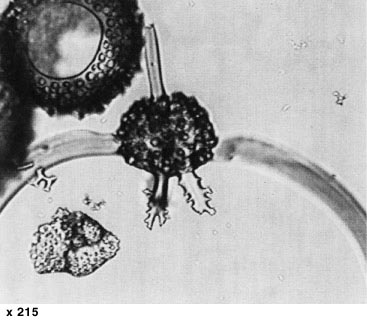 Dorcadospyris
pseudopapilio Moore
Dorcadospyris
pseudopapilio Moore Dorcadospyris
pseudopapilio Moore
Dorcadospyris
pseudopapilio MooreDorcadospyris pseudopapilio Moore, 1971, p.738, pl.6, figs.7-8
Shell nut-shaped, tuberculate, thick-walled with a slight external indication of a sagittal stricture. A conical apical horn is present in most specimens. Two primary feet, circular in section and divergent at approximately 180°. These feet curve semicircularly and in some specimens cross or join. Two secondary feet, tabular in section, located at joint of the sagittal and basal rings. Along the lateral edges of these secondary feet, remnants of an irregular lamellar meshwork can usually be detected. This species is distinguished from Dorcadospyris papilio by the difference in their secondary feet (Moore, 1971).
Based on 30 specimens. Length of apical horn 19-134 µm; of shell 56-95 µm; of primary feet 416-1002 µm; of secondary feet 19-77 µm. Breadth of shell 19-117 µm (Moore, 1971).
D. pseudopapilio differs from all other species of Dorcadospyris by the two lamellar, distinctively laterally fringed secondary feet. This fringe has been described as resembling the irregular remnants of a latticed meshwork, but it is more reminiscent of the form of the margin of some lichens (Sanfilippo et al., 1985).
The nut-shaped lattice-shell usually bears a well developed apical horn, but this is absent in some specimens. The two strong primary feet diverge initially at 180° or slightly more or less, curve semicircularly, often cross and occasionally join. Secondary feet are only two in number, laterally fringed (Sanfilippo et al., 1985).
 DISTRIBUTION
DISTRIBUTIONProbably because sediments from its short stratigraphic range have seldom been encountered, this species has been found only in the Oligocene of the tropical Pacific and the Caribbean. Its morphotypic first and last appearances both lie within the Theocyrtis tuberosa Zone.
This short-ranging species (middle early Oligocene) originated at the very beginning of the genus Dorcadospyris - some specimens transitional from Tristylospyris triceros to Dorcadospyris ateuchus have the secondary feet lamellar, fringed laterally.
Additional illustrations can be found in Dinkelman, 1973, pl.4, figs.2-3.
The consistent and unique nature of the secondary feet distinguish this species. Although the primary feet are usually strongly divergent (equal to or greater than 180°) as in Dorcadospyris papilio, some specimens have primary feet that diverge at an angle somewhat less than 180° (Moore, 1971).